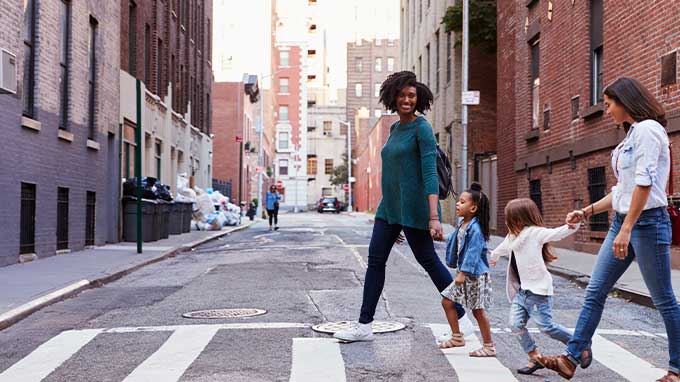Research In Action
Research In Action
Breadcrumb

When my oldest child became a "walker," a student who no longer qualified for school bus transportation due to how close his family lived to the local school, I became much more concerned about the safety of crossing streets without me. This task depends on multiple developmental factors, including a child's ability to assess the speed of incoming traffic, to predict how long it would take to cross given a certain walking speed, and to judge how large the gap needs to be to reach the other side of the street with time to spare.
Needless to say, crossing the street became something we practiced very frequently until I felt that I could trust my son's judgment.
Since I am not far removed from this experience, I was excited to come across a recent study that assessed the impact of how parents coach their children while crossing virtual roadways. Specifically, the study aimed to explore the impact of a child's age on the way parents and children talked about and moved through a virtual intersection and examined whether the timing of a child's movement through the intersection could be predicted by differences in parent-child communication.
What They Did
Over 60 parent-child dyads (with children ages 6, 8, 10, and 12 years) were presented with an immersive virtual environment simulating a traffic roadway. They were instructed to wait for the first car to pass and then to attempt to cross the road without being hit by a car. They were also instructed to decide together when they thought it was safe to cross.
Crossing performance was measured by:
- the number of seconds in the gap selected for crossing
- timing of movement that included synchronization of road entry by parent and child, the timing of gap entry, the road-crossing time, and the amount of time to spare (how large the gap needs to be to reach the other side of the street with time to spare)
Communication between parent and child was measured by:
- the total number of gaps suggested and opposed by each dyad member during each trial
- use of an anticipatory gap selection strategy (defined as some reference to an upcoming gap) versus immediate gap selection (crossing without warning)
- frequency of post-crossing feedback and perception of risk of crossing by each dyad member
What They Found
- The subject population was 78% European American, 14% Asian, 3% African American, and 1.5% Hispanic.
- Most parents had a 4-year college degree or more (~70%).
- Children suggested gaps more frequently than parents overall, particularly among 8-, 10-, and 12-year-olds.
- Parents in dyads with 6- and 8-year olds were more likely to oppose gaps than children.
- As children became older, parents were:
- less likely to use anticipatory gap strategies
- less likely to have chosen the gap
- As children became older, they were:
- more likely to use anticipatory gap strategies
- more likely to have chosen the gap
- Dyads with 12-year-olds took more of the larger gaps and fewer of the smaller gaps than dyads with 6- or 8-year-olds
- After reaching the other side of the roadway, parents and children discussed the outcome of the crossing during only 19% of trials
- Children's use of an anticipatory gap selection strategy was associated with a 0.11 second increase in gap size, but parent use of an anticipatory gap strategy did not predict gap size.
- Parent use of an anticipatory gap section was associated with 0.08 second reduction in children's timing of entry and 0.13 second increase in children's time to spare relative to the approaching vehicle.
What This Means
It makes sense that parents more frequently suggest and also oppose the gaps when with younger children. It also makes sense that parents more frequently use an anticipatory gap selection strategy when with younger kids (whereas children themselves more frequently used an anticipatory gap selection strategy at older ages).
Using the anticipatory gap selection strategy predicted more precise timing of entry, as well as time to spare by children, which I think is a key point and potential recommendation to discuss with families when discussing pedestrian safety. Understanding how these results compare to the real-world environment, as well as among a more racially/ethnically diverse population, would help to apply findings to a more general population.




